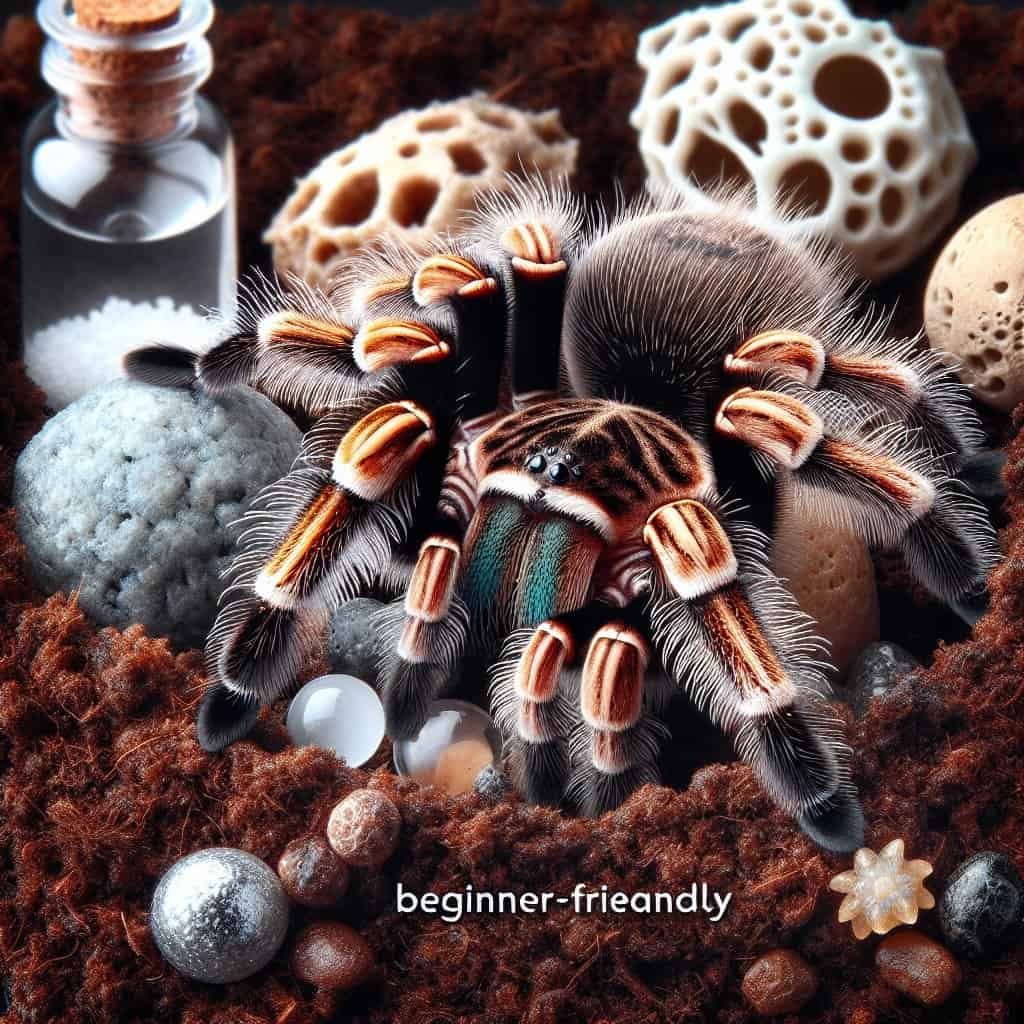Are you a pet owner who is looking to add a unique and exciting member to your family? If so, we have just the suggestion for you – beginner-friendly exotic spider species. These captivating creatures not only offer a sense of wonder and fascination but also make for low-maintenance and interesting companions. Whether you are a seasoned spider enthusiast or new to this world, we have enlisted a list of exotic spider species that are perfect for beginners. Get ready to embark on an extraordinary journey with your new eight-legged friend!

1. Tarantulas
Tarantulas are some of the most fascinating and popular spiders to keep as pets. They come in a variety of sizes and colors, making them an attractive choice for spider enthusiasts. Here are three beginner-friendly tarantula species that you should consider if you’re thinking about getting a pet spider.
1.1 Chilean Rose Tarantula
The Chilean Rose Tarantula, also known as the Rose Hair Tarantula, is one of the most docile and low-maintenance tarantula species to keep. With its beautiful pinkish-brown color and calm temperament, it’s a favorite among beginners. This tarantula is generally slow-moving and not aggressive, making it an excellent choice for handling and observing.
1.2 Mexican Redknee Tarantula
If you’re looking for a visually striking tarantula to add to your collection, the Mexican Redknee Tarantula is a great choice. Its black body with vibrant red-orange knees creates a stunning contrast. Despite its intimidating appearance, this tarantula is generally quite docile and can be easily handled with caution. It requires a well-ventilated enclosure and a diet consisting mainly of crickets and other small insects.
1.3 Brazilian Black Tarantula
The Brazilian Black Tarantula, also known as the Black Velvet Tarantula, is a visually captivating species with its jet black body and velvety appearance. This tarantula is known for its calm demeanor and ease of care, making it suitable for beginners. It prefers a warm and humid environment, with temperatures around 75-85°F (24-29°C) and moderate moisture levels. As with most tarantulas, a diet of small insects like crickets is sufficient.
2. Jumping Spiders
Jumping spiders are known for their incredible leaping abilities, vibrant colors, and unique hunting techniques. They are generally smaller in size compared to tarantulas but make up for it with their bold personalities. Here are three beginner-friendly jumping spider species that you might consider as pets.
2.1 Bold Jumping Spider
The Bold Jumping Spider, also known as the Daring Jumping Spider, is a common species found in North America. Its striking black body with white markings and bright red or orange chelicerae make it visually stunning. Despite its name, this jumping spider is not aggressive and can be easily handled with care. It requires a relatively small enclosure with plenty of vertical space for climbing and hunting.
2.2 Regal Jumping Spider
The Regal Jumping Spider, also known as the Magnolia Green Jumper, is a charming and visually appealing spider species. With its vibrant metallic green body and intricate markings, it stands out among other jumping spiders. This species is known for its calm disposition and ease of care, making it suitable for beginners. It thrives in enclosures with plenty of climbing opportunities and a varied diet consisting of small insects like fruit flies and pinhead crickets.
2.3 Johnson’s Jumper
Johnson’s Jumper, also known as Johnson’s Green Jumper, is a small and colorful jumping spider species found in the United States. It showcases a striking mix of green and yellow colors on its body. Easy to care for and relatively docile, this spider species is a great choice for beginners. A small enclosure with some plant cover and ample feeding opportunities will keep this jumping spider happy.
3. Huntsman Spiders
Huntsman spiders are known for their large size, impressive speed, and unique hunting abilities. While some species can be challenging to handle, there are a few beginner-friendly options for those interested in keeping them as pets. Here are three Huntsman spider species suitable for beginners.
3.1 Giant Crab Spider
The Giant Crab Spider, also known as the Heteropoda venatoria, is a relatively large spider species known for its crab-like appearance. It has long legs and a brownish coloration, making it visually intriguing. Despite its size, this spider species is generally docile and can be handled with caution. It requires a spacious enclosure with plenty of hiding spots and room for climbing.
3.2 Brown Huntsman Spider
The Brown Huntsman Spider is a widespread species found in various regions around the world. It has a distinctive flattened body and long legs, enabling it to squeeze into narrow spaces while hunting. Despite its intimidating size, this tarantula species is typically not aggressive towards humans. However, it is important to handle them with care due to their speed and agility. Providing a large enclosure with hiding spots and vertical elements, such as branches or cork bark, is essential.
3.3 Silver Huntsman Spider
The Silver Huntsman Spider, also known as the Isopeda villosa, is another fascinating huntsman spider species that is suitable for beginners. It has a unique silver-gray coloration and a relatively calm temperament. This spider prefers a warm and humid environment, along with plenty of vertical space for climbing. Providing a well-ventilated enclosure with hiding spots and foliage will create a suitable habitat for this species.
4. Wolf Spiders
Wolf spiders are known for their robust builds, powerful hunting abilities, and unique maternal instincts. They are agile and quick, making them fascinating spiders to observe in a captive environment. Here are three beginner-friendly wolf spider species that you might consider for your arachnid collection.
4.1 Carolina Wolf Spider
The Carolina Wolf Spider is a large, stocky spider species with a relatively docile temperament. It can be found in various habitats throughout the southeastern United States. This wolf spider has excellent eyesight and is a skilled hunter. Its dark brown coloration helps it blend into its surroundings while waiting for prey. A spacious enclosure with some substrate and hiding spots, such as rocks or bark, will provide a suitable home for this species.
4.2 Florida Wolf Spider
The Florida Wolf Spider is another impressive species found in the southeastern United States. It is known for its large size and bold black and white coloration, making it visually striking. While this species is mostly docile, it can be quite fast and agile, so handling should be done with caution. A well-ventilated enclosure with substrate and vertical elements, such as cork bark, will create a comfortable habitat for this wolf spider.
4.3 Southern Hogna
The Southern Hogna, also known as the Hogna carolinensis, is a relatively large wolf spider species that inhabits the southern United States. It has a robust build and is typically brown or gray in color, enabling it to blend in with its surroundings. While it may appear intimidating, this spider’s temperament is generally docile, making it suitable for beginners. A spacious enclosure with some substrate, rocks, and bark will provide a suitable habitat for this wolf spider.

5. Orb-Weaver Spiders
Orb-weaver spiders are known for their intricate webs, impressive silk-spinning abilities, and beautiful color patterns. While some species can be easily disturbed, there are beginner-friendly options for those interested in keeping orb-weaver spiders as pets. Here are three orb-weaver spider species suitable for beginners.
5.1 Marbled Orb Weaver
The Marbled Orb Weaver, also known as the Araneus marmoreus, is a captivating orb-weaver spider species found in various regions around the world. It showcases intricate patterns on its abdomen, with a mix of browns, whites, and grays. Despite its somewhat delicate appearance, this spider species has a relatively calm temperament and can be easily observed in an enclosure. A well-ventilated habitat with ample space for web-building will keep this orb-weaver spider content.
5.2 Golden Silk Orb Weaver
The Golden Silk Orb Weaver, also known as the Nephila clavipes, is a visually stunning spider species known for its large webs and golden-colored silk. It has a relatively docile temperament and can be frequently found in tropical and subtropical regions. This orb-weaver spider requires a spacious enclosure with vertical elements to build its intricate web. Regular feeding with small insects will sustain this spider’s nutritional needs.
5.3 Spotted Orb Weaver
The Spotted Orb Weaver, also known as the Neoscona crucifera, is a common orb-weaver species found throughout the United States. It has a unique coloration pattern with black spots on a white or yellow background. This spider species is generally not aggressive and can be easily observed in an enclosure. Providing a suitable habitat with enough space for web-building and a varied diet consisting of small insects will ensure the well-being of this orb-weaver spider.
6. Fishing Spiders
Fishing spiders, also known as nursery web spiders, are named for their incredible ability to walk on water and hunt aquatic prey. While not as common in the pet trade as other spider species, there are a few beginner-friendly options worth considering. Here are three fishing spider species suitable for beginners.
6.1 Six-Spotted Fishing Spider
The Six-Spotted Fishing Spider, also known as the Dolomedes triton, is a large and visually appealing spider species found in North America. It is known for its ability to walk on water, making it a fascinating species to observe in captivity. This spider species has a relatively calm temperament and can be easily handled with care. A well-maintained enclosure with access to water and some vegetation will provide a suitable habitat for this fishing spider.
6.2 Dark Fishing Spider
The Dark Fishing Spider, also known as the Dolomedes tenebrosus, is another North American fishing spider species that can be kept as a pet. It has a dark brown coloration and a robust build. While this spider may appear intimidating, it is generally not aggressive towards humans. A spacious enclosure with access to water and plenty of hiding spots, such as rocks or wood, will create an ideal habitat for this fishing spider.
6.3 Dolomedes Spider
Various species within the Dolomedes genus, commonly referred to as Dolomedes spiders, make suitable pets for beginners interested in keeping fishing spiders. These spiders have a broad distribution, with different species found in North America, Europe, Asia, and Australia. They are known for their ability to catch aquatic prey and their relatively docile temperament. A well-maintained enclosure with access to water, along with some substrate and hiding spots, will create a comfortable habitat for these fishing spiders.

7. Trapdoor Spiders
Trapdoor spiders are named for their unique method of hunting, where they build camouflaged burrows with hinged trapdoors to ambush unsuspecting prey. While some species may require specific care, there are a few beginner-friendly trapdoor spiders suitable for pet owners. Here are three trapdoor spider species to consider.
7.1 Eastern North American Trapdoor Spider
The Eastern North American Trapdoor Spider, also known as the Ummidia spider, is a native species found in the coastal regions of the southeastern United States. It constructs long, tubular burrows with a hinged trapdoor at the entrance. This spider species has a relatively calm temperament and requires a well-maintained enclosure with suitable substrate for burrowing. Care should be taken when handling as these spiders can be delicate.
7.2 Sydney Funnel-web Spider
The Sydney Funnel-web Spider, also known as the Atrax robustus, is a famous Australian trapdoor spider species. While it is important to note that some species within this group are venomous and not suitable for beginners, several non-venomous species make great pets. The Sydney Funnel-web Spider requires a well-maintained enclosure with suitable substrate for burrowing, along with proper humidity levels. It is best to avoid handling this spider due to its defensive nature.
7.3 Armband Trapdoor Spider
The Armband Trapdoor Spider, also known as the Myrmekiaphila neilyoungi, is a fascinating spider species found in the United States. It constructs burrows with elaborate trapdoors and showcases unique armband-like markings on its legs, giving it its name. This spider species is typically docile and can be observed without the need for handling. Providing a suitable enclosure with adequate substrate for burrowing and occasional feeding of small prey items will ensure the well-being of this trapdoor spider.
8. Tarantula Relatives
Tarantula relatives encompass a diverse group of spiders that share some similarities with true tarantulas but belong to different families and have their unique characteristics. Here are three tarantula relative species suitable for beginners.
8.1 Tailless Whip Spider
The Tailless Whip Spider, also known as the Amblypygi, is a fascinating arachnid that is often mistaken for a spider but belongs to a different order. It has a unique appearance, with elongated front legs resembling antennae, giving it a somewhat alien-like appearance. This tarantula relative is generally docile and can be easily observed in a suitable enclosure. It requires a proper habitat with some substrate, hiding spots, and moderate temperatures for optimal care.
8.2 Vinegaroon
The Vinegaroon, also known as the Whip Scorpion or Grampus, is another spider-like arachnid that is not a true spider. It is known for its defensive mechanism of releasing a vinegar-like spray when threatened, hence its name. Vinegaroons have a unique appearance, with a long whip-like tail that they use for sensory purposes. They are generally docile and relatively easy to care for in a suitable enclosure. Providing a habitat with appropriate substrate, hiding spots, and occasional misting to maintain humidity levels will keep this tarantula relative comfortable.
8.3 Giant Solifugid
The Giant Solifugid, also known as the Camel Spider or Sun Spider, is a fast and formidable-looking arachnid that often gets mistaken for a spider. Despite its appearance, this tarantula relative is not venomous and poses no threat to humans. However, its speed and active nature may make it less suitable for beginners. A properly sized enclosure with hiding spots and moderate temperatures will create a suitable habitat for this tarantula relative.

9. Ogre-Faced Spiders
Ogre-faced spiders, also known as net-casting spiders, are named for their unique hunting technique of building a specialized web between their front legs and using it as a net to capture prey. While some species may require specific care, there are a few beginner-friendly ogre-faced spider species suitable for pet owners. Here are three ogre-faced spider species to consider.
9.1 Deinopis Spider
The Deinopis Spider, also known as the Net-Casting Spider, is a visually striking spider species known for its elongated front legs and large eyes. These spiders construct a silken net that they hold between their legs and cast onto unsuspecting prey. This spider species has a relatively calm temperament and can be easily observed in a suitable enclosure. Providing a habitat with some vertical elements for web placement and an occasional diet of small insects will sustain this net-casting spider.
9.2 Net-casting Spider
The Net-casting Spider, also known as the Deinopidae family, includes several species known for their unique hunting strategy. They construct a specialized silken net that they hold between their front legs and cast onto prey. As they are nocturnal hunters, they require a habitat with low light levels and plenty of vertical space for web placement. Providing a well-maintained enclosure with a suitable substrate and feeding them a varied diet of small insects will ensure the well-being of this ogre-faced spider.
9.3 Scytodes Spider
The Scytodes Spider, also known as the Spitting Spider or Spitting Scytodes, is a unique spider species known for its ability to immobilize prey by spitting venom. While they do not build webs like other ogre-faced spiders, they exhibit fascinating hunting techniques. This spider species has a relatively calm temperament and can be easily observed in an enclosure. It requires a suitable habitat with hiding spots and occasional feeding of small insects to thrive.
10. Widow Spiders
Widow spiders are infamous for their potent venom and iconic red hourglass-shaped markings on their abdomen. While not suitable for beginners due to their potentially dangerous venom, it’s worth mentioning a few species for those who may have more experience or interest in highly venomous spiders. Here are three widow spider species:
10.1 Black Widow Spider
The Black Widow Spider is perhaps the most well-known widow spider species, notorious for its potent neurotoxic venom. Identified by its shiny black body and distinctive red hourglass marking, this spider is best observed from a safe distance and avoided as a pet for most individuals. If you have expertise and experience in handling venomous spiders, you must provide an experienced and specialized habitat for this spider, mimicking its natural environment and consulting professionals for guidance.
10.2 Red Widow Spider
The Red Widow Spider, also known as the Latrodectus bishopi, is another member of the widow spider family. As the name suggests, this species exhibits a vibrant red coloration on its body, contrasting with its black legs. Like other widow spiders, the Red Widow possesses venom that can be harmful to humans. Keeping this species as a pet requires expertise and proper precautions to ensure safety. Consultation with professionals and expert guidance should be sought if considering this spider.
10.3 Brown Widow Spider
The Brown Widow Spider, a close relative of the Black Widow, typically exhibits a tan or brownish coloration with varying markings on its abdomen. While it possesses venom, it is generally considered less potent than that of the Black Widow. Despite being relatively less venomous, caution should still be exercised when handling or observing this spider. Due to their potentially harmful bites, experience and knowledge in working with venomous spiders are essential before considering the Brown Widow Spider as a pet.
In conclusion, there is a wide range of exotic spider species suitable for beginners interested in keeping them as pets. From the docile and low-maintenance tarantulas to the fascinating hunting techniques of ogre-faced spiders, there is a spider to suit every arachnid enthusiast. It is important to research and understand the specific care requirements and potential hazards associated with each species before bringing them into your home. Always prioritize your safety as well as that of the spider when considering arachnid ownership.

